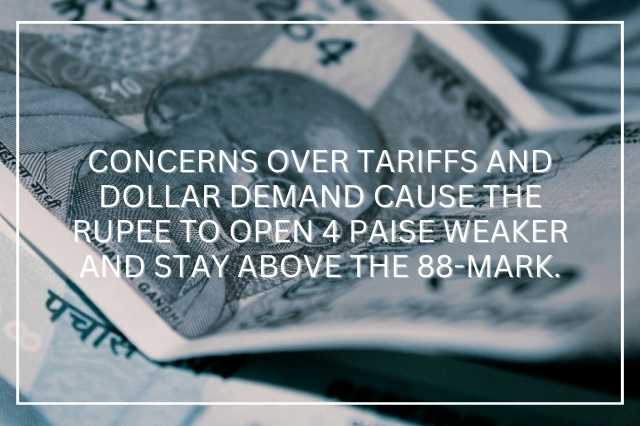
loading...

Concerns over tariffs and dollar demand cause the rupee to open 4 paise weaker and stay above the 88-mark.
Due to uncertainties around tariffs, month-end dollar demand, and foreign outflows, the Indian rupee broke below the 88/USD barrier on Friday to attempt a new low and began 4 paise worse at 88.2450 on September 1. Several market investors were taken aback by the rupee's decline over 88, as they had anticipated a more forceful response from the Reserve Bank of India. Experts in the money market now worry that the Rupee may continue to face pressure in the future. Anil Kumar Bhansali, Head of Treasury and Executive Director at Finrex Treasury Advisors LLP, stated, "The Indian rupee could remain under pressure as the US tariffs and FPI outflows pile pressure and Government bonds fall after consistent outflows with yields to 10-year rising to almost 6.70 percent before closing at 6.57 percent." "For the USD INR, 87.75 serves as a support and 88.50 as a resistance," stated Shinhan Bank's Head of Treasury Kunal Sodhani. "The next focus for markets is identifying the level where the RBI signals it will not tolerate further losses," a treasury officer with a mid-sized bank was quoted by Reuters. A court decision that declared the majority of Trump's tariffs unlawful, Friday's US PCE pricing data, and the US President's ongoing battle with the Federal Reserve over efforts to replace Governor Lisa Cook are all factors that traders are considering, according to currency experts. The Indian rupee’s slide past the 88-mark against the US dollar has heightened concerns in financial markets, as persistent dollar demand and foreign portfolio outflows continue to weigh on sentiment. The currency opened weaker amid month-end importer requirements and the backdrop of tariff-related uncertainties, leaving traders cautious about further downside risks. Market experts believe that while the Reserve Bank of India has traditionally stepped in to curb sharp volatility, its muted response this time may indicate a preference for allowing the currency to adjust naturally. However, any sustained weakness could push up import-led inflation, especially in crude oil and commodities, which may eventually force the central bank into more active intervention. Global factors are also exerting pressure on the rupee. Investors are closely tracking the US PCE inflation data, which could influence the Federal Reserve’s policy stance, and ongoing political tensions in Washington surrounding leadership at the central bank. Additionally, a recent court ruling against Trump-era tariffs has injected further uncertainty into the global trade environment. With technical support placed at 87.75 and resistance at 88.50, analysts expect the rupee to trade in a volatile but defined range in the near term. Market participants are now watching for clear RBI signals on the level of depreciation it is willing to tolerate before stepping in with stronger measures.
Just Login and Customize
Our Features Easily.
USERNAME : [email protected]
PASSWORD : admin1234